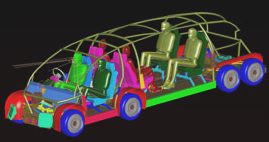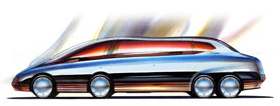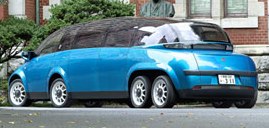|
It
looks like a Fiat show car, seats eight people, has eight wheels, and
weighs 3-1/4 tons. It's powered by 84 lithium-ion batteries. Behold the KAZ, the Keio
Advanced Zero-emission vehicle, 22 feet of out-of-the-box thinking by
professor Hiroshi Shimizu of Tokyo's Keio University.
The peculiar fruit
of a five-year, $4 million project funded by the Japan Science and
Technology Corporation, KAZ posts some pretty amazing numbers, including
acceleration from 0-to-62 mph in 7 seconds; a quarter-mile in 15 seconds;
and a top speed of 193.3 mph during a session at the Nardo test track in
Italy last year. At 62 mph it can cruise for almost 200 miles on a single,
one-hour charge; Shimizu is working to double that.

Considering these statistics, which seriously challenge GM's celebrated fuel-cell concept vehicle, the Hy-Wire (built on the Autonomy
chassis), Shimizu was understandably crestfallen when, at this year's
Detroit auto show, he received but two orders for the KAZ. Dr
Shimizu was expecting 100 orders to make the KAZ a commercial proposition
at just US$400,000 a piece.
Apart from the miscalculation on order potential, Shimizu's 25-year career has been
typical Japanese ideal engineering, a methodical step-by-step pursuit of
new technology guided by singular insights. Key among these is the notion
that, if electric vehicles are to succeed in the marketplace, they must
transcend the staid appliances that have so far hit the boulevard.
Dr Shimizu has designated his projects with letters. His first electric
car, the 1978 A car, was a converted Subaru Leone with lead-acid batteries
and two electric motors attached to the front wheels. His next project,
the B, was a motorcycle, and it introduced Shimizu's signature technology,
the in-wheel drive system. In-wheel drive integrates an electric motor
with regenerative braking (the motor turns into a generator to charge the
battery when the brakes are applied), a mechanical brake, a
torque-multiplying gear and a wheel bearing into a single, compact unit.
The system, says Shimizu, minimizes mechanical energy loss between a motor
and a wheel, decreases overall weight, and increases cabin space.
Wheel-integrated motors are nothing new. Several companies, such as
Technologies M4 in Quebec, have shopped prototype designs. The big
difference here is the sheer number of horses Shimizu is able to harness
with his in-wheel propulsion systems. The KAZ motors use compact
rare-earth magnet motors (neodymium-iron) putting out 74 lb.-ft. of
torque. Combined with a 4.588:1 gear ratio, each 12,000-rpm motor produces
a whopping 55 kilowatts from 42 kg of unit weight. Let's do the math: 8 x
55kW = 440kW, or 590 horsepower.

And this from just the G car! "Mr. Ford made 20 cars from Ford A
until Ford T," Shimizu notes. "I believe we can spread electric
vehicles widely until T-car." The KAZ uses a flat chassis—an aluminum structure shaped like the kind
of gift box that ties come in—inside which are stuffed the fourscore and
four 3.75-volt/88-ampere-hour lithium-ion batteries, along with assorted
systems for steering, pneumatic suspension and electronic control units.
The KAZ chassis is a mere 5.1 inches thick—quite a bit more svelte than
the Hy-Wire's 11 inches.
So why strange shape? Because cutting-edge tech is expensive, says Shimizu. An electric
limousine could command the premium price necessary to cover the KAZ
costs, and justify itself with its luxury and silent refinement. Thus the
eye-bedeviling eight-wheel design and attenuated wheelbase. The primary
advantage of this design is that it uses smaller wheels and tires,
limiting intrusion of the wheel wells into the cabin space. It also gives
the KAZ very stable cornering, as the center of gravity seems as if it's
somewhere around the Earth's mantle. And, as Shimizu points out—paranoid
executives and unpopular heads of state take note—the KAZ can continue
even if several of its wheels and tires are knocked out by "external
violence."
The KAZ's styling—call it Minority Report goes to the prom—was
designed by IDEA Institute, coach builders in Turin, Italy. "When we
first examined professor Shimizu's project, we felt extremely
dubious," says Elena Corona of IDEA. "How were we going to
handle his eight wheels, each combined with an electric motor, and all
connected to a highly sophisticated parallelogram suspension system?"
IDEA's solution was to confine steering to six wheels. The front two axles
steer in phase, the third is the neutral point, and the fourth steers in
counter-phase up to 6.2 mph. The electric power steering is mechanical on
the front two axles but drive-by-wire on the fourth, handled by a control
unit that senses what is happening in the front two steering boxes. After
the kinematics were sorted out, it was relatively easy to wrap the KAZ in
its exotic sheet metal, which has a coefficient of drag of 0.30.
What's next? You can't accuse Shimizu of not listening to what the
marketplace is trying to tell him. His next project is swimming in sex
appeal—a luxury sports car, à la Porsche 911, with which he expects to
set a world electric-vehicle record of around 250 mph.

SPECIFICATIONS
Vehicle Type
Fully electric, 8-wheel-drive, 8-passenger, 6-door sedan
Motors
Eight 6-phase synchronous Nd-Fe electric motors
Power (each) 74 hp
Torque (each) 74 lb.-ft.
Max Speed 12,000 rpm
Batteries
Eighty-four Li-ion batteries
Voltage (each) 3.75V
Capacity (each) 88 A•h Weight (each) 7.7 lb.
Dimensions
Length 263.8 in.
Width 76.8 in.
Height 65.9 in.
Weight 6,578 lb.
Performance
0-TO-62 MPH 7 sec.
Quarter-Mile 15.3 sec.
Top Speed 193.3 mph
Range 186.5 mi.
Electric
Vehicle Laboratory, Keio University
144-8
Ogura, Saiwai, Kawasaki, Kanagawa
212-0045, Japan
Tel:
+81-44-580-1565
Fax: +81-44-580-1435
|


